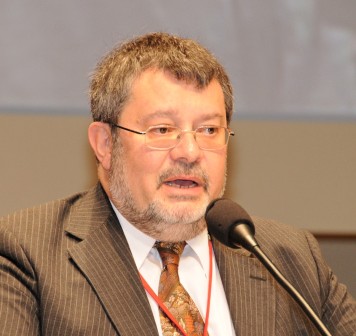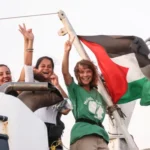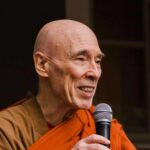 – Hans Ucko –
– Hans Ucko –
?No religion is an island? is a paraphrase on John Donne?s powerful words: ?No man is an island?. I have many times heard this paraphrase by the Jewish scholar A.J. Heschel and I have often used it myself. It is strange that we have to say it. Of course no religion is an island. Islam cannot do away with its links to Christianity and Judaism. There is a bridge between Judaism and Christianity. Buddhism is related to Hinduism and there is an intrinsic link between Jainism and Hinduism. Sikhism is not possible to understand without its context in India.
People of different religions have lived together since time immemorial. India is maybe the best example of people of different religions living together. Hindus, Christians, Muslims have lived and are living together. So, what?s so new about interreligious dialogue that we now need to provide advice about potentialities and pitfalls? Maybe interreligious dialogue is new in the sense that religion in dialogue seems to be taken out of its context in culture, ethnicity, tradition, history and presented as a thing in itself. One of the most important pitfalls is that we think that we can present religion as an entity in itself. It is a similar reduction of religion as when we reduce a human being to one identity. He is Hindu or Muslim or Christian as if this said it all. It doesn?t. We are not only Christians or Muslims, we are Christians in India and not in the US, we are Muslims in Europe and not in Pakistan. The difference is important.
Increased mobility, large-scale movement of refugees, and economic migrations has resulted in more people of different faiths living side-by-side. What has been a centuries-old experience in India has in our time become a world-wide experience. But living side-by side doesn?t immediately mean contact and interaction. Where mechanisms for dialogue and encounter exist, there are opportunities to foster greater knowledge and awareness among people of different religions. Unfortunately, increased relations between communities have on the other hand often been marred by tension and fear. For many communities, this tension seems to confirm a need to protect identities and distinctiveness. But a legitimate search for identity is easily amalgamated with hostility towards neighbors of other religions and cultures and everything is blurred. We witness today throughout the world and among the followers of major religious traditions a rise in influence of movements and leaders, who for the sake of political expediency seek to mobilize their believers in the name of preserving a perceived threatened distinctive identity.
One of the most dangerous manifestations of identity is in ethnic conflict, where more often than not religious identities, loyalties, and sentiments become components in pushing sharp distinctions between ?we? and ?they.? My identity is defined over against the other. When people are elevating their identity as a banner or looking for ways of either inventing or reinventing ethnicity, enemies are essential. We witness today many vehement assertions of identity and we are constantly exposed to the formation of group identities over against a common enemy. A particular politics of identity based on a sense of victimization, reducing identity to a single affiliation, facilitates the creation of ”identities that kill”, says the French-Lebanese author Amin Maalouf. We see it often. The resentment of the West in many parts of the Muslim world, the frustration against the US for its foreign policy in relation to some Arab states and Israel feeds Usama bin Laden and his followers. The perceived humiliation of the Arab nation is an incitement to the creation of an identity, which defines itself as being constantly under attack. The perceived marginalisation of migrants in Europe furthers a self-image and identity, which is only defined as underdog. The reaction is self-marginalisation and in the end, when there is no longer any hope or future visible, or no light in the tunnel, an explosion of violence.
The problem with identity is when it is made into an absolute. Maalouf warns against an understanding of identity, which portrays itself as a sort of fundamental truth, an essence ?determined once and for all at birth, never to change thereafter?. Not to fall into this abyss or pit, we should reject reducing ourselves or being reduced to one identity alone. We are more than Christians and that is a good thing.
We may have lived side by side with people of different faiths but we may not have interacted with them as Muslims or Hindus per se but only as neighbors. When in the name of dialogue we come together as Hindus and Christians, we should make it a point that our coming together is not only marked by dialogue but that we seek genuine relationships with people of different faiths. This is particularly important as we live in a time not only of an increased awareness of religious plurality; we are also witnesses to the potential role of religion in conflict, the growing place of religion in public life, all presenting us with challenges that require greater understanding and cooperation among people of diverse faiths.
Whenever religious plurality gives rise to communal tensions there is a possibility of religious sentiments being misused. Religion speaks for some of the deepest feelings and sensitivities of individuals and communities; it carries profound historical memories and often appeals to uncritical confessional solidarities. Interreligious relations and dialogue are meant to help free religion from such misuse, and to present opportunities for religious people to serve together as agents of healing and reconciliation. In a number of countries there are dialogue partners who are able to cooperate, across the religious divide, in concrete efforts of peace making. There are also cases where religious leaders are invited to play a visible role in state-sponsored peace initiatives. It has worked in local contexts but also in some national and regional situations of conflict: I am thinking of Hindus and Muslims working together to heal communalism in Mumbai and in Gujarat. I am thinking of the Interreligious Council of Sierra Leone, which brought an end to conflict in the country. This is a potential in dialogue, which we should cultivate.
But it is also a potential pitfall. The impact of dialogue in the context of conflicts may disappoint high expectations. When it is unable to quell conflict, its relevance is questioned. There are often expectations that dialogue can significantly contribute towards resolving political or communal conflicts and restoring peace, in situations where religion seems to be implicated. However, by its very nature, interreligious dialogue is not an instrument to instantly resolve problems in emergency situations. Dialogue is not an ambulance. Dialogue is prophylactic health-care. Contacts and relations of precious trust and friendship between people of different religions, built quietly by patient dialogue during peacetime, may in times of conflict prevent religion from being used as a weapon. In many cases, such relations may pave the way for mediation and reconciliation initiatives. At times of communal tension or at the peak of a crisis, contacts across the communal divide may prove to be invaluable in the construction of peace.
Efforts to prevent polarization between religious communities at the world level are more important than ever. Through media, people tend to perceive conflict in one place as part of a conflict in another, causing enmities in one part of the world to spill over into other regions. An act of violence in one place is used to confirm the stereotype of the “enemy” in another place, or even to provoke revenge attacks elsewhere in the world. The crisis between Muslims and Christians concerning the Danish cartoons of Mohammed is a case in point. We must as much as it is possible try to de-globalize situations of conflict and analyze each one within its own context. The emphasis on the specificity of every context does of course not prevent people of faith in other parts of the world from being both concerned and involved. An interreligious engagement in one place may in fact be an essential contribution to peace building and reconciliation in another place. Also good news can travel well across our planet. It is a potential of dialogue that it can enable people of different religions to foster a counter-culture in situations when stereotyping is rife. In some places in the US, following September 11, Christians and Muslims provided another message than the stereotyping of Muslims as terrorists. They were together, prayed together and countered the dangerous simplifications. They refused to be separated from each other in times of hate speech and lynching mentalities.
Individuals and communities may, even with the best of intentions, encounter problems and difficulties in interreligious relations and dialogue. Sometimes the call for dialogue is met with hesitation, suspicion, indifference or opposition both from within one?s own community and from other religious communities. Although dialogue by its very nature is direct encounter, there are invisible participants on each side in every dialogue. Our dialogue partners will mutatis mutandis every so often hold us responsible for what fellow Christians have done or neglected to do, said or not said. Muslims will recall the crusades in their dialogue with Christians. Hindus will remind Christians of the inevitable link between mission and colonization. Jews will recall the long history of anti-Judaism and anti-Semitism in Christian Europe. And even if it is not mentioned aloud, the crusader and colonialist-cum-missionary are invisibly present. It is a pitfall to think we can come to a dialogue as if there was no history before us.
But not only history colors the dialogue. Religion is not a monolith and religious people are not all the same even if they belong to the same religion. I can think of few other instances than religion, where ?pars-pro-toto? seems to set the rules. A religion can be whole-sale dismissed because a meeting with a protagonist of that particular religion went wrong. While I may be open to dialogue, there are co-religionists of mine, troubled and disturbed from meeting people of other faiths, who through their attitude affect the way people of other faiths look upon my religion. There are deep disagreements within religions and we know that the dividing lines do not always go between religious communities but often within religious communities. The differences may not be only theological, but relate to social, political, and moral issues. We may for various reasons find ourselves in opposition to some of those with whom we share a common faith. In fact, one experience in dialogue is that one sometimes may feel closer to a person of another faith than to the person next to you in the pew. You may not share the same faith but there is an affinity and relationship that transcends religious boundaries. The saying by Ernst Simon is an experience of many: ?The people I can pray with, I can’t talk to, and the people I can talk to, I can’t pray with.?
We come in many religious communities across people who seem to be primarily interested in the growth of their own community through various forms of mission and proselytism. They seem to have little interest in dialogue or may make use of it to further their missionary design. Dialogue is their method to get to know the other more in depth, but for a purpose that is not one of dialogue. One wants to learn what is holy in the religious tradition of the other in order to proselytize better. Such situations can be discouraging for people willing to engage in dialogue. I recall a rabbi, who said:? My relationship with the Divine is like my relationship with my wife. There comes a moment when I want to close the bedroom door so that no one can watch my wife me and making love. The same goes for my relationship with God. It is not for public consumption, dialogue or not!?
Dialogue cannot only be an occasion to come to terms with issues of divergence. Dialogue will wither if we only meet in the context of divisive issues. Dialogue offers also a possibility and space to building alliances on issues of common concern between people of different faiths. It is important to seek such partners and explore ways of rebuilding the credibility of dialogue enabling people to enter a relationship of mutual respect and openness in discussing divisive issues or seeking ways of a common witness.
Interreligious dialogue needs intra-religious dialogue. It raises also the importance to work intra-religiously with our inter-religious findings, i.e. to inform our community about our findings in and through interreligious relations in order that we may tell our brothers and sisters about what we have learned from our friends of other faiths: what is important, which are the sensitivities in relation to religious traditions, etc.
Motivations for dialogue can sometimes be conditioned by power relations between religious communities and by the importance, objective and subjective, of numerical disparities. Discriminatory practices exacerbate distrust and divi
sion. The intermingling of state policies and confessional identities rooted in communal traditions may lead communities to look at each other as a threat. This is particularly true in times of uncertainty or political and constitutional changes involving a redefinition of state-religion relationships. Interreligious dialogue cannot shy away from recognizing the effects of uneven power relations and the impact of mutual perceptions, no matter how distorted they are. The relevance of dialogue initiatives depends largely on their intentional and concentrated effort to dispel fears and suspicions between those who are seen to represent religious communities. Equally, it is essential that interreligious dialogue creates an opportunity for strengthening cross-confessional loyalties, always upholding, in discussion and joint action, the centrality of the common good and inclusive political participation.
Linked to the issue of power is the reality of asymmetry in dialogue. It is not a given that we mean the same when entering into dialogue and we may not be in the dialogue for the same reasons. One might be in the dialogue because being in dialogue is part of being religious: spirituality and religious commitment is strengthened and intensified. The other may be in dialogue because he wants to address a controversial issue. One wants dialogue for spirituality; the other wants to have the dialogue partner support a need: a Muslim cemetery, the right to kosher or halal slaughter. A Christian will in dialogue with Jews try to find out more about the early church and the first Christians. The Jewish partner wants a Christian support for the politics of the State of Israel.
In dialogue we nurture relations. Building bonds of relationship with those considered “the other” is the goal of all dialogues. Such bonds however are not built easily or quickly. Therefore patience and perseverance are crucial in the practice of dialogue. The tenacity to go on, even when the fruits are not obvious, is one of the basic disciplines of dialogue. In dialogue we grow in faith. For Christians, involvement in dialogue produces constant reappraisal of our understanding of the Biblical and theological tradition. Dialogue drives all communities to self-criticism and to re-thinking the ways in which they have interpreted their faith traditions. Dialogue brings about change in the experience of faith, helping people to deepen and grow in their faith in unexpected ways.
Some would due to their experience in dialogue confess that in the relationship with the other, one?s faith in God has grown and changed. They have over and over again met with God, and they have learned that God is more, that God is ?Allah-u-aqbar? or as Jacob said it, ?God, you are here and I didn?t know it?. They have come to understand that God truly has many mansions. They have come to appreciate that one cannot exhaust God, that God is always ?Deus semper maior?; one cannot grasp God, understand God, hold God. ?God is unknowable and incomprehensible. The only thing knowable and comprehensible about God is his unknowability and his incomprehensi?bility?, said St John of Damascus.
But there is a pitfall, the pitfall of saying it is all the same. All religions are the same. Behind all religions there is one religion. Every religion is like a river and they all unite in a sea, where they become one sea. While it is beautiful and even sometimes helpful to look at how much unites us, there is a risk of going for the lowest common denominator or for avoiding the beauty of difference. Appreciating difference frees us from thinking that we hold it all in our hands, that we understand it all. Difference, diversity is such a good teacher to help us not to fall into the pitfall of hubris. Difference is such a good experience for realizing that we still are not there, we do not possess the truth and that we in our otherness need each other to know better where to go and where not to go. The other is in his or her otherness a constant invitation to walk together towards the whole truth. No one has it and it is only as we remain with each other that we will see the whole truth or as the following story has it where not to go for the whole truth.
A man was lost in a dense, dark forest. As the daylight faded into the lengthening shadows of dusk and the thickness of night gathered, he became more and more frightened. After three days and nights of this painful feeling of being hopelessly lost, he became desperate.
Finally, on the fourth day of wandering about, at dusk, he saw something approaching him from afar. He filled his pockets with rocks to throw and prepared a heavy club from a branch with which to defend himself. His heart beat wildly in his breast. The perspiration of fear gathered on his brow as the unknown creature loomed larger and larger as it approached. It was as tall as a man. He crouched behind some bushes. He grabbed for some of the sharpest stones and prepared to attack frozen with fear.
Then, he realized that the frightening creature monster was a human being. He threw the stones away, but kept his grip on the club just in case. When the man was all but upon him, he threw the club away too as he threw his arms about the shoulders of the man. It was his own brother!
The man held on to his brother with love and gratitude. “Thank God you came in search of me. Please show me the way out of the forest.”
One brother looked at the other with tears in his eyes as he answered: “I am lost now too, my brother. But I can show you what paths NOT TO TAKE. Together, we will find the way out.”[1]We are in it together. We are thrown at each other and we need each other. No religion is an island.
Participation in multireligious prayer has become increasingly common as a consequence of involvement in interreligious dialogue. Concrete situations of everyday life provide opportunities for encounter with people of different religions: interreligious marriages, personal friendship, praying together for a common purpose, for peace or in a particular crisis situation. But the occasion can also be a national holiday, a religious festival, a school assembly, and other gatherings in the context of interreligious relations and dialogue. There are various forms of pr
ayer among people of different religions. For some, praying together could be a spiritually enriching occasion, for others it is anathema.
Prayer-life is intimate. We pray in our native tongue or use a language that is intimately associated with prayer. Interreligious prayer cannot be thrust into the life of dialogue. There is a potential and there is a pitfall. We need to keep both in mind. There are questions to be addressed. Does prayer mean the same thing for all of us? Certain religious traditions are doing what has been done since ages: same hymns, same psalms, and same liturgy. This is what is important, you do the same things. This is what gives you comfort and meaning, whereas in another religious tradition there is no problem having a new liturgy, having new prayers for each occasion etc.
Coming together to pray is not so easy. It is my experience that we also in such a peaceful thing as interreligious prayer cannot rule out power as a factor. The dominant religion will set the tone also in interreligious prayer. In an interreligious praying for peace at the 38th parallel between the two Koreas, the one setting the tone for all the other religious traditions present was Christianity and in this case Korean Presbyterians. The dominating discourse was Christian and in the liturgy Buddhists and Muslims said Buddhist and Muslim prayers as if they were Presbyterians.
The question is also what we do in interreligious prayer? The Pope in Assisi 1986 made an interesting distinction in his invitation the Prayer for Peace. He invited people to come together to pray. He did not invite people to come to pray together.
And yet it is the latter, which is particularly challenging. One has been together from different faiths for a long time, working together, studying together and now one would like to express this fellowship and love for each other in prayer together. In expressing together in prayer the fears of all, the worries, the hopes, the dreams, the gratitude, this is what one is longing for.
Prayer together is an invitation to friendship. It is an invitation to enter into the mystery of the Ultimate, which is beyond human intellectual grasp and understanding. It is a sign of the unity of humanity. We recognize the reality of religious diversity, which for us constitutes a theological mystery. Interreligious prayer may be viewed as a relational bridge: between peoples, between faith communities, between religions. Interreligious prayer may lead us to acknowledge the sacred that is present in the religious experience of the other.
There is however a danger of reducing the prayer to the lowest common denominator and of losing the distinctive richness of each tradition. If the intent is to mould the resources of the multiplicity of religions involved into a single act of prayer, a blended unitary content that may reflect each of the participating groups, there is a risk that not one of us will feel at home. While a base-line of harmony and acceptability may triumph, the lowest common denominator risks destroying the distinctive and particular. The outcome is a blend belonging to no particular tradition: it sits outside the orbit of the religions concerned; it is a liturgical orphan, a spiritual hybrid. Were this the only mode of interreligious prayer it would be justly criticized as a reductionist enterprise.
But there is also a thematic conjoining of prayers, or other appropriate input, from the contributing religions, around a particular event or need or common communal point of reference. The real differences and unique dimensions and contexts, as well as the different content, of the contributions are mutually respected and upheld: there is no sense, through the event, of uniting the religions as such, or subsuming them under some inclusive umbrella of any one of them, or advocating the notion of a supra-religious identity embracing them all in and through the prayer-event. There is no attempt to blend the diversity into a kind of spiritual porridge; nor is the outcome marked by the happy randomness of a smorgasbord. It is a prayer with mutual commitment; persons from different faith traditions use mutually authentic language, rites, and symbols to express their common commitments to transcendent Reality and one another. The development of such a covenant relationship in community grows out of deep commitment to one another and involves the profound difficulties such a commitment entails. Consequently this form of interfaith coming together is often rare and profoundly meaningful.
The issue of interreligious prayer is a fitting end to our walking through potentialities and pitfalls in interreligious dialogue. The way out is not easily seen. We need each other to remember what sensitivity in relation to prayer, worship and spiritual discipline means. It is however in our deepest relations to God that our embrace of dialogue is to be rooted, in our religious tradition, in our spiritual longing and in our awe that God is making everything new.
[1] The story was first told by the late Rabbi Marshall Meyer at the WCC Assembly in Canberra 1991. I have shortened it and modified it.
Rev. Dr. Hans Ucko is the President of Religions for Peace Europe and is a Fellow in Interfaith Studies at Hartford Seminary, CT. He lives in Switzerland and Sweden.











